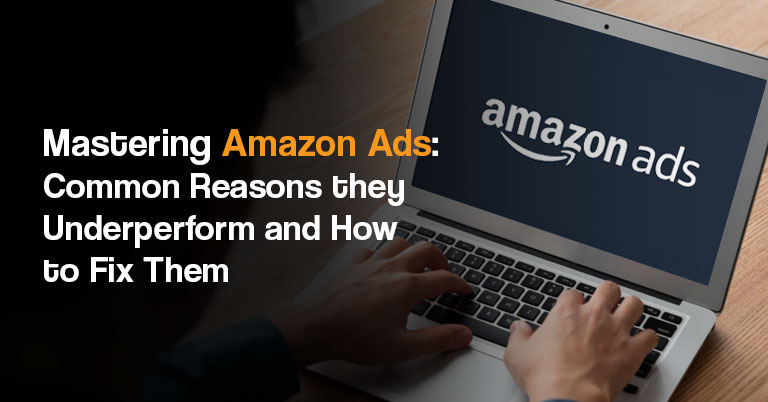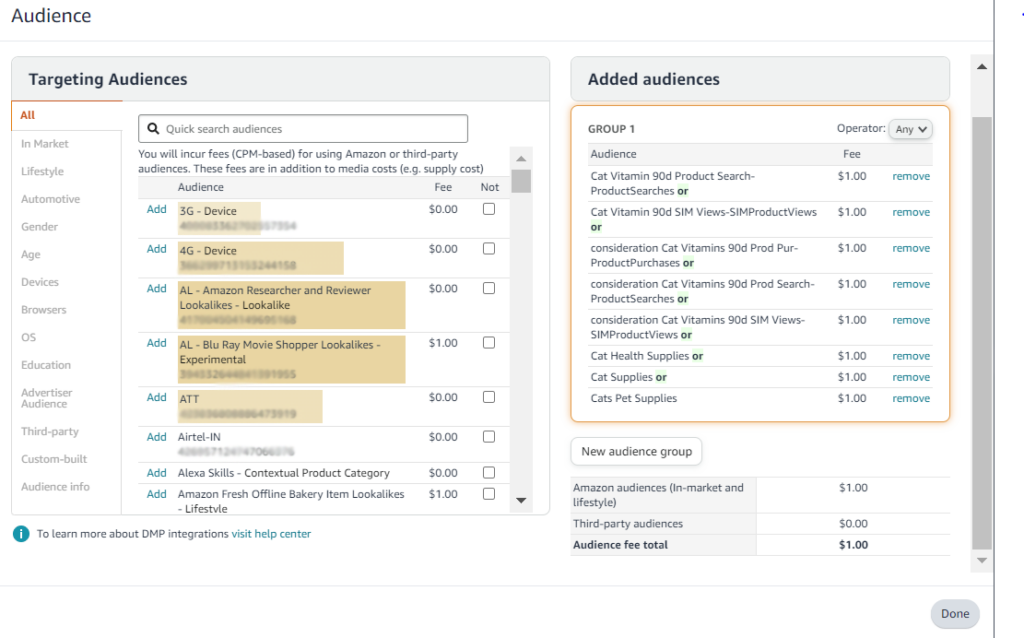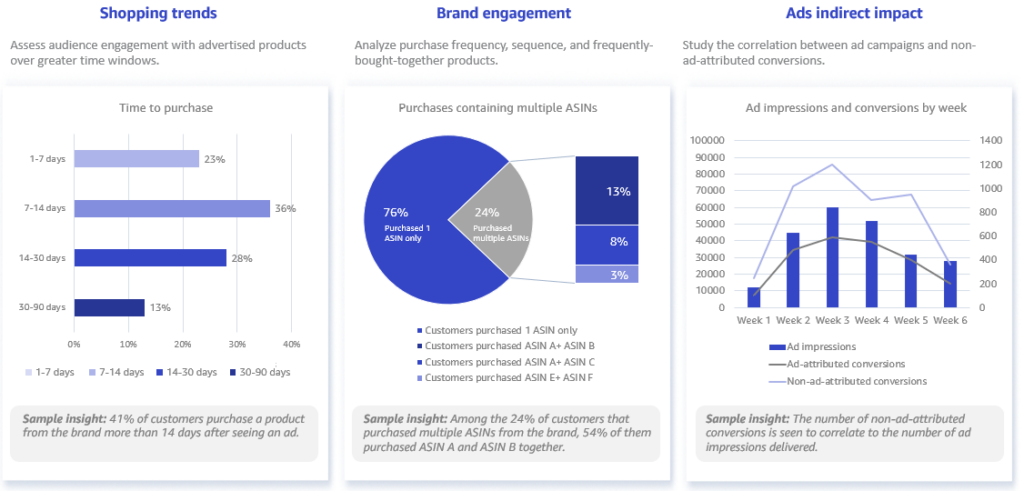
Introduction
Did you know that Amazon’s ad business accounted for over $14.3 billion in Q3 2024 alone, making it one of the fastest-growing advertising platforms globally? With millions of daily shoppers and countless optimization opportunities, these ads have become fundamental to Amazon PPC strategies for all businesses aiming to improve visibility and drive sales.
Unfortunately, even the best ad campaigns fail if they fail to draw attention, address consumer queries, and match their purchasing intent. If your ads aren’t performing well, it might be a good time to revisit your campaigns, identify what is holding them back, and, more importantly, fix them.
Table of Contents
- Introduction
- Why Could your Amazon Ads be Underperforming?
- Proven Amazon Ad Management Strategies: Optimizing Campaign Performance in Each Situation
- Summarizing all Amazon PPC Optimization Strategies
- What to Expect of Amazon PPC in 2025: Anticipated Shifts and Strategies?
- How Team4eCom Can Help you with Amazon Ads Optimization?
Why Could your Amazon Ads be Underperforming?
As per BigCommerce, a commonly used benchmark for RoAS (Return on Ad Spend) is 4:1. This means that for every $1 spent on ads, you should ideally generate $4 in revenue. However, achieving this target RoAS (tRoAS) is often challenging for many businesses.
Despite their best efforts, several factors can cause Amazon ad campaigns to fall short of expectations. Let’s explore the most common scenarios in which ad campaigns underperform and how to address these issues effectively.
Scenario #1: Your Ads are Not Getting Any Clicks
The most intuitive reason behind an underperforming ad is the lack of clicks. It could be due to the following:
- Your ads are not discoverable; they’re probably unable to secure a top position on the SERP.
- Your ads are discoverable. However, they’re not appealing to the target audience.
This may be because of inefficient bidding, low content relevance, unattractive ad creatives, poor keyword targeting, or an overall poor ad structure that fails to draw attention.
Scenario #2: Your Ads are Getting Clicks (and Spends), but No Sales
Say your ads appear at the top (somewhere in the first half of the first SERP) and result in more website visits. Despite this, the increasing visibility (or traffic) is not translating to actual sales. This trend suggests that your Amazon ad campaign might be attracting an irrelevant audience and failing to reach (or please) the intended customer segment. If the intent behind the search query isn’t addressed in your Amazon ad, users are less likely to engage.
Scenario #3: You Now Have it All—Clicks, Spends, and Sales; but the ACoS is Too High
While increased clicks, higher ad spending, and improved sales may seem like signs of success, ACoS is another factor that can still undermine your PPC strategy. A high ACoS means you’re spending too much on ads compared to the revenue generated, reducing your potential profit from the campaign.
This often occurs due to overbidding, overusing broad-match keywords, unappealing product listings, and poorly optimized ad campaigns.
Regardless of the scenario, underperforming ad campaigns can silently kill your Amazon PPC strategy.
Proven Amazon Ad Management Strategies: Optimizing Campaign Performance in Each Situation
Having worked with numerous global clients and optimized countless Amazon PPC campaigns, we’ve identified a set of proven strategies that improve overall ad performance. That said, ad optimization is not a one-size-fits-all solution. So feel free to see what works for you and addresses specific challenges, be it low clicks, high ACoS, or poor conversion rates, and even tackle the above-mentioned scenarios.
To Attract More Clicks
1. When your Ads are Not Discoverable
- Expand Keyword Usage: Besides including high volume, broad match keywords, include long-tail, intent-focused key phrases and related terms. You can use tools like Semrush and Google’s Keyword Planner to do the same. However, ensure you refrain from certain words/terms restricted by Amazon.
- Optimize Keyword Bidding: If your bids are too low, try increasing the bids for high-intent, relevant keywords (even if they have a relatively lower search volume) to secure better ad placements.
If you still struggle to select keywords while adhering to the platform’s terms and prioritize them based on intent as well as search volumes, you can seek help from content optimization service providers. Their experts can devise a personalized, high-performing keyword strategy for your ad campaigns.
Want to see how this works in action? See how we helped one of our clients maximize Amazon Sales with a low ACoS, all within a budgeted ad spend. We carefully selected top-ranking keywords, avoiding the platform’s restricted terms to ensure compliance and overall better performance.
2. When your Ads are Discoverable but Not Attracting Visitors
If that’s the case, the issue likely lies with the ad content, its relevance, and consumer targeting. Consider doing the following:
- Identify audience segments with a high purchase intent.
- Create engaging, keyword-rich ad titles and content after determining the target customer search intent.
Amazon provides a dedicated platform called the DSP (Demand Side Platform), which plays a key role in advanced audience targeting and programmatic bidding strategies. It uses Amazon’s first-party data to identify and target audiences with high purchase intent based on their search queries and previous interactions and recommends ad placements accordingly. Moreover, Amazon DSP can also enable programmatic ad buying across Amazon properties (like Twitch, IMDb, etc.) and other third-party platforms.
Here is what advanced audience targeting on Amazon DSP looks like:

To Translate Clicks (and Ad Spend) into Sales
Lack of sales clearly points to gaps in your listing content. If this is your problem area, focus on optimizing your product listings.
- Make product titles specific, benefit-driven, and optimized with relevant keywords to grab attention.
- Provide clear, concise, and compelling descriptions highlighting the problem your product will solve, its key features, and unique advantages.
- Use a reader-friendly content format like bullet points. They are easily scannable, especially when mentioning highlights, such as material and dimensions.
- The product images you use must be high-resolution, well-lit, and showcase multiple angles of the product. You can also include lifestyle shots to help buyers visualize the product realistically.
Another smart way to capture attention and entice users to buy your product is to offer time-limited deals, discounts, or promotional codes that create a sense of urgency. Additionally, you can use Amazon coupons or subscribe-and-save options to cater to price-conscious customers.
While it sounds manageable, many businesses realize it’s not exactly the same later in the process. This is why it is often advisable to collaborate with professional experts specializing in product listing optimization. They can handle everything, from creating ad copies, listing creation, and content optimization to product photo editing and SEO.
Finding it hard to believe? See how one of our clients experienced a 47% increase in sales with professional ad optimization support.
To Optimize ACoS
According to the industry average, an Amazon ACoS of 30% to 40% is considered “good.” By definition (ad spend/ad revenue), anything above this range implies spending more than the generated sales, and vice versa.
Do the following to stop a high ACoS from eating into your profits:
- Monitor Ads and Adjust Bids Regularly: Use Amazon’s dynamic bidding options, such as “Down-Only” or “Up and Down,” to let Amazon adjust your bids based on conversion likelihood. You should also regularly monitor metrics like CTR, CPC, and conversion rates. This will help you track campaign performance.
You can also rely on the Amazon Marketing Cloud (AMC) to get performance insights beyond surface-level metrics. With AMC as a part of your PPC strategy, you can monitor the entire consumer journey, from the initial ad click to the final purchase. You can also get dashboards with shopping trends, ad impressions, etc. This level of monitoring positions you to determine more effective ad types, target keywords, and even ad placements.
Below is a snippet of an AMC dashboard:

- Refine your Keyword Strategy: Target less competitive long-tail keyphrases to reduce CPC and attract high-intent shoppers. Another highly effective way is to leverage negative keywords to eliminate wasted ad spend.
- Work on your Overall Campaign Structure: Separate high-performing products from low-performing ones and allocate ad spending accordingly. You can also experiment with different ad types (Sponsored Products, Sponsored Brands) to find the most cost-effective options for your campaigns.
- Consider Seasonal Trends: Amazon PPC campaigns cannot optimally perform in auto-pilot mode throughout the year. As seasonal trends affect consumer behavior and product requirements, you must factor this into your strategy and adjust bids & target keywords accordingly.
- Leverage Automation: Amazon offers numerous features to automate campaign management. For example, you can use automated targeting options for close matches, loose matches, substitutes, and complements. Moreover, in addition to dynamic bidding, Amazon provides a suggested bid range based on competition and keyword performance data. If you struggle with bid optimization, you can also seek help from Amazon PPC experts.
- Focus on High-Margin Products Separately: Optimize spending on products with better profit margins to improve the balance between ad spend and revenue. High-margin products generate greater profit per sale, allowing you to absorb ad spend more effectively while maintaining profitability. In this case, costs take up a smaller percentage of revenue.
Want to learn more? See how strategic implementation of the above-mentioned strategies can bring down your ACoS to as low as 16%!
Summarizing all Amazon PPC Optimization Strategies
| Scenario | Problem | How to Improve Amazon Ad Performance? |
|---|---|---|
| To Draw More Clicks | Low visibility due to poor bidding or ineffective keywords | – Increase bids for high-intent, relevant keywords, even with lower search volumes. – Include long-tail, intent-focused keywords alongside broad match terms. – Use tools like SEMrush or Google’s Keyword Planner for keyword strategy. – Seek help from Amazon A+ content writing service providers for personalized keyword optimization. |
| To Translate Clicks into Sales | Poorly optimized product listings and content gaps | – Optimize product titles with specific, benefit-driven keywords. – Write concise, compelling descriptions that highlight benefits and features. – Use high-resolution images with multiple angles and lifestyle shots. – Offer discounts, promotions, or time-limited deals to create urgency. – Collaborate with Amazon Ads optimization experts for end-to-end ad and listing management. |
| To Optimize ACoS | High ad spend without proportionate sales | – Bid strategically, increasing bids on high-converting keywords and reducing bids on low-performing
ones. – Use long-tail keywords to reduce CPC. – Add negative keywords to filter out irrelevant clicks. – Prioritize high-margin products and adjust campaigns for seasonal trends. – Leverage automation tools like dynamic bidding to optimize ad performance. |
What to Expect of Amazon PPC in 2025: Anticipated Shifts and Strategies?
1. Dynamic Creative Optimization (DCO)
Although the concept of dynamically adjusting ad creatives has existed since 2011, it has gained significant traction only in recent years. The market, valued at USD 0.8 billion in 2023, is projected to grow to USD 1.99 billion by 2032.
DCO allows advertisers to create modular ad templates containing multiple creative variations. AI algorithms dynamically select and combine the most relevant elements—such as headlines, images, and CTAs—in real-time, tailoring ads to individual user profiles and interaction history. This ensures that each ad resonates more effectively with its target audience.
Unfortunately, Amazon has not yet developed native DCO capabilities on its platform. However, near similar optimization of Amazon ads for better ROI can be accomplished with its DSP platform. You can expect more developments, including native DCO integration, in this area.
2. Emphasis on First-Party Data for Customer Targeting
Customer targeting has become more challenging, partly due to Google’s and other search engines’ growing restrictions on search data scraping. These limitations stem from concerns over the malicious use of scraped user interactions across the web.
This is why many businesses, including Amazon itself, now rely on first-party data—the information is collected directly from customers through their interactions with a brand, including website visits, purchase history, and feedback. In fact, according to Forrester Consulting research, using first-party data in your marketing strategy can improve conversion rates by 72%. See how SunTec India delivered a robust, performance-optimized app for simplified barn management with real-time updates and role-based user access.
3. Increasing Preferences for Video Ads
Shorter attention spans have shifted consumer preference toward video ads that deliver product/service-related promotional content. This has resulted in a vast global digital video advertising market, projected to grow at a CAGR of over 20% in the next five years. So expect more video ads, even on platforms like Amazon.
How Team4eCom Can Help you with Amazon Ads Optimization?
There’s no refuting the fact that eCommerce has become highly competitive. And underperforming ads, in such a scenario, are a recipe for low visibility, sales, and, eventually, profitability. This is why achieving optimal ad performance is imperative but not readily achievable. Complex keyword bidding, managing ad placements, creating compelling ad content, and optimizing product pages can quickly become overwhelming, all while controlling your ACoS.
That’s where Team4eCom can make a difference. We handle every aspect of your campaigns, from managing ad strategies and A/B testing keywords for better CTR to optimizing ad content and product listings. Our dedicated team of Amazon marketing experts manages every aspect of your campaigns, ensuring no detail is overlooked.
We understand the impact of rising ACoS on your profits, which is why outsourcing Amazon PPC services to us means you can count on strategies that prioritize ROI. Let us handle the complexities of Amazon advertising so you can focus on confidently growing your business.

 +44 203 514 2601
+44 203 514 2601 +1 585 283 0055
+1 585 283 0055